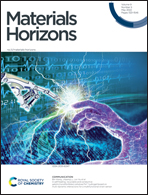Absolute film separation of dyes/salts and emulsions with a superhigh water permeance through graded nanofluidic channels†
Abstract
The development of multifunctional films with a high permeability has been of great concern for effective separation of complex aqueous contaminants, especially in the face of zero or near-zero release regulations. Inspired by the natural structure of sandy soils, polydopamine-wrapped/connected polypyrrole sub-micron spheres (PPSM) were closely packed onto a polypyrrole-coated bacterial cellulose (PBC) support, by which a new two-layered PBC/PPSM composite film formed with graded nanofluidic channels. Interestingly, after being soaked in complex water environments of ethanol, acids, bases, heat, cold and high salinity, or else bended/folded for more than 10 times, the structure and performance of this film still stayed the same, validating its high structural stability and flexibility. Even in a high salinity environment over seawater, this PBC/PPSM film exhibits a dye-separation capacity of almost 100% with a surprisingly superhigh water permeance over one thousand L h−1 m−2 bar−1, one or two magnitudes higher than that of the related films reported in the literature. Meanwhile, the ability for effective oil–water-separation was also validated. Besides the superhydrophilicity and underwater superoleophobicity, the synapse-like-structure-induced graded nanofluidic channels are also proposed to play a key role for rendering such an outstandingly comprehensive performance of the film by greatly overcoming fluid resistance and reducing permeation viscosity.



 Please wait while we load your content...
Please wait while we load your content...